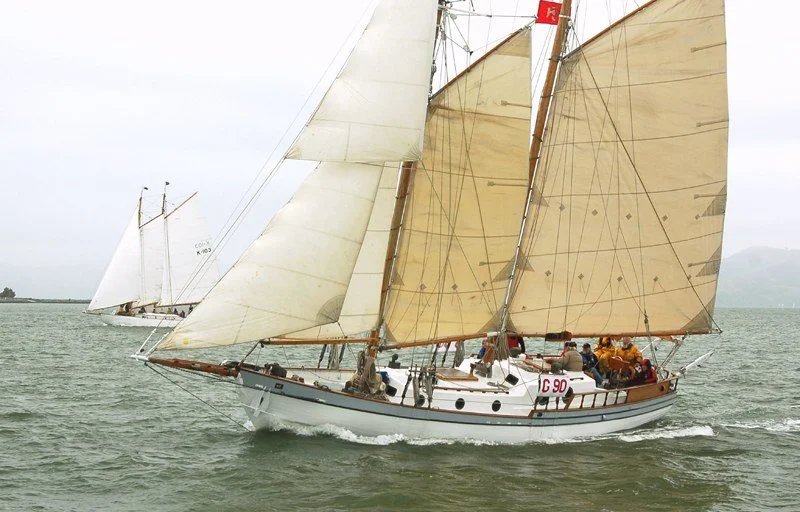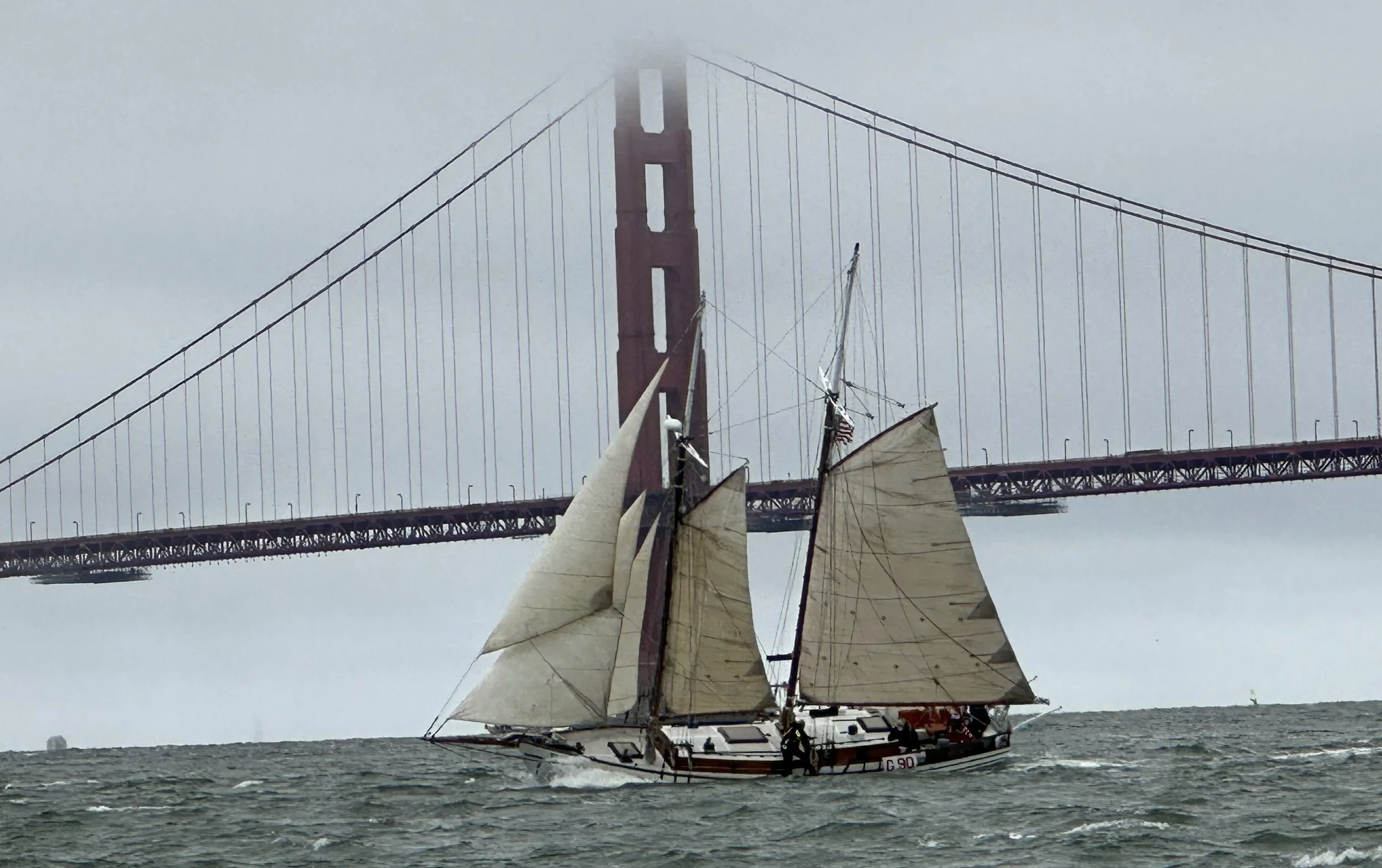Aida
History
Her history in two parts, reflecting her life as AIDA and later as ELIXIR.
She was originally requested from Thomas E. Colvin as a commercial vessel, built in Taiwan in the mid-sixties for the Hawaii fuel trade. As such, she was constructed with a large hatch amidships for loaded barrel of diesel, and her ballast was also originally internal, consisting of lead and scrap iron. If you look carefully on some of the frames you can still see the scuff marks from them, under the paint. She did the fuel trade for a while, but I assume it became uneconomic at some point in the early 70's when more of the islands got hooked up via undersea cable to a central power system.
At any rate, she was bought by a consortium of brothers and friends for long-line fishing in, and sailed to, Alaska. I speculate that it was because of the fuel crisis, when quite a lot of sailing vessels where pressed into service as fishing vessels, in the face of rising fuel costs. She spent maybe 10 years up there in the hands of various owners, sometimes as a fishing boat, sometimes for private use. In the early to mid-80's she was purchased by an Oregon couple that sailed her down the west coast from Alaska to San Diego, and from there over to her old home, Hawaii. I spoke to a gentleman that sailed a catamaran in her company on that trip, and he said that they never caught up with her once she left San Diego, and arrived in Hawaii 2 days before they did. For some reason I have never been able to find out, the Oregon couple left Aida on the hook in a small bay in the islands for 4 years. Maybe they just liked Hawaii and lacked either the finances or the motivation to leave. Whatever the reason, Aida was caught in a tropical storm still at anchor, was dismasted and sunk.
There, her story would have ended where it not for the Rudells (twin brothers). They claimed salvage and raised her, stripped her of paint to find her teak still in excellent condition. From there, they completely rebuilt her, dropping out the keel, replacing the stem and apron timbers, refastening all the planking, redesigning and rebuilding her decks, coachhouse and interior layout. They took all the internal ballast and fashioned a new iron keel for her, and fixed a long lead shoe to that. They launched and rigged her new spruce masts, and called her Elixir. Along with one of the brother's wife and their son, they did some local cruising of the islands for a short time before departing for Vancouver, BC. As you probably know, there is basically two ways to get to the Pacific Northwest from Hawaii. The first is to sail north then east, hopefully have mostly a broad reach the whole way. The other is to make straight for coast and head north, and while shorter, is against the prevailing wind conditions the whole way. They chose latter route and the four of them apparently had bad weather for the whole 3,000 mile trip. Conditions must not have been too pleasant aboard, because the wife filed for divorce when they made landfall, and as the case proceeded she demanded the sale of the vessel in an effort to recoup some of the US $250,000 that had been invested in her four year rebuild, from 1989 to 1991.
In 1998, she was still for sale, at a price guaranteed not to sell her, and that's when we first saw her. It was very much "nice boat, shame about the price".
Construction
She is a gaff rigged schooner with a displacement hull with straight bo:w and a transom stern. The hull is constructed of I ¼ 11 teak planking over 3 "x 3" bent frames at 12” average centers. There are interconnected longitudinal bilge and hull stringers. Bronze screw fastenings. The decks are of l II marine plywood over 211x 311 deck beams at 12" average centers. The cabin and coach roof is constructed of 1” marine plywood over 2"x 3" mahogany deck beams at 12’ average centers. The decks are plywood and epoxy. The hull fastenings, decks and housework are new construction in 1991, with the exception of the ribs and keel.
She was built in 1964 using commercial quality construction techniques of the time, and rebuilt in 1991. This created a new boat with the benefit of a modem well-ventilated interior and traditional construction techniques. She sailed from Hawaii to Victoria, B.C. where she subsequently won an award at the Victoria Wooden Boat Festival.
FROM: Thomas E Colvin, June 2002
RE: AIDA aka "ELIXIR"
I can see your being puzzled with dates. The plans were prepared in 1955-56 which indicates that I started them near the end of one year and finished them early in the following year. I do remember that the original owner sought out bids from builders on the Gulf and Pacific coasts and do not remember why she was built in Taiwan, I remember a client mentioning that she was several years under construction and that she did sail those waters prior to sailing to Hawaii. Early 1964 is probably the right date. In those days when an owner purchase plans it was not uncommon for the hull not being built for several years, the record is IO years to start construction. When I designed the hull for a builder then the launching was just a matter of months. It wasn't until the mid 1970s that my wife started a cross filing record of each vessel built.
The fuel crisis had little or nothing to do with fishing under sail. It was a matter of economics due to the long distances the vessels had to sail. Aida I know worked with 5 other schooners of my design and they worked the Bering Sea and then sailed towards and sometimes to the Solomon's. I was in Puerto Rico in 1977-78 when the mother ship came in to unload at the Bumble Bee plant. All her catch was by long lining and the captain mentioned that he was and had been getting fish from my schooners and did mention that Aida was a High Liner for a couple of years i.e. she landed more fish per man than any other vessel. In those days the vessels were out for a year at a time. Refueling was done from the motlier ship or from one of my larger schooners that carried 5000 gals of fuel for this purpose. One of my 66' schooners is still fishing in the Bering Sea. The Capt who has been with her for 17 years deems her the most comfortable and best sea going vessel he has ever been aboard. He was seeking a larger version of her. I asked if he had problems getting crew and he said he had a waiting list of applicants .
Other things that changed was the cost of constructing a wood vessel and by 1968 nine out of ten new hulls were steel the exact opposite to what it was in the mid 50ies. Today the ratio is 300:1 in favor of steel. Fishing laws changed, the vessels grew in size from 40’ - 60’ to over 100’ - 150’. They were all power vessels, seining replaced for the most part the long liners. Freezing and processing aboard and factory ships just ran the smaller fishing vessels out. Then speed became important and the few small vessels remaining needed more speed and then they could supply the fresh market.
After Hawaii and Alaska became states the Jones Act was imposed which meant that foreign built vessel could not be used. Then quotas came in, and then numerous other laws have been enacted, none of them good ones. Most of the sail fishing vessels went into the freight business uritil the massive road construction allowed trucks to take over. About the same time the small 60' Dutch coastwise motor vessels were dumped on the market when the new and larger vessels were built in the 1970's. Today the few schooners that I design for cargo are all foreign flag. Some do fairly well and repay for themselves in 1 O years and most will never repay themselves but just make a living and their maintenance for the owners.
Back to Aida, I have been told that she carried case oil in Hawaii and that she also fished there but I don't know for how long. She like my other schooners are noted for their passage making ability. Day after day they tum in good runs and are fine all around sailers. There are only a few of the package freight sailing vessels that I designed just for speed. Motor vessels, trucks and air planes chased them out of business. Today most of my junks and other sailing vessels just carry a lot of cargo of the non perishable variety and are cheap enough to run that they can upon arrival be used as floating warehouses until the price is right.
In power we all know that the shortest distance is a straight line. Those ofus who grew up in sail knew that the shortest distance was the one that gave us fair winds. I have seen numerous marriages and relationships dissolve because the owner just lacked the ability to recognize this. Just in the past couple of weeks I have an owner who wants to get rid of his schooner because she wouldn’t sail at 45º to the wind in a heavy sea so that he could keep a schedule.
Stats
-
LOA 55"
LOD 42’
Beam 12’
LWL 34’
Draft 6’
-
Thomas E. Colvin
-
Schooner
-
Gaff Rigged Schooner
-
34,000 lbs
6,000 lbs ballast
-
G90
-
-
Taiwan
-
1964
Rebuilt 1989-91
-
Melissa & Andrew Flick


